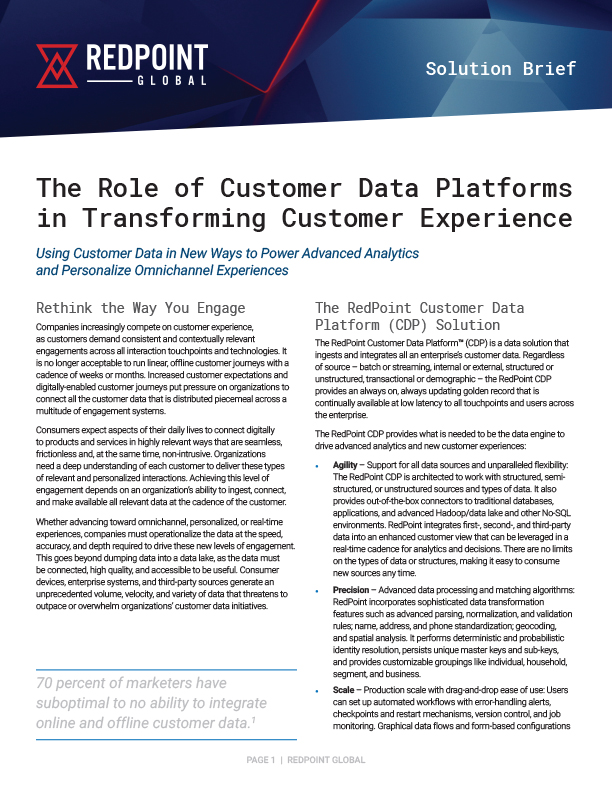 In January, I wrote a blog that addressed many of the common misconceptions about the customer data platform (CDP). One misconception people have is that a CDP can deliver dynamic customer journeys out-of-the-box, without the hard work of the seemingly endless business user and technical configurations that must be completed for a CDP to truly differentiate the business.
In January, I wrote a blog that addressed many of the common misconceptions about the customer data platform (CDP). One misconception people have is that a CDP can deliver dynamic customer journeys out-of-the-box, without the hard work of the seemingly endless business user and technical configurations that must be completed for a CDP to truly differentiate the business.
A CDP is an application that manages a persistent, unified customer database for a single view of the customer. Its purpose is to support real-time decisioning and omnichannel orchestration with an accurate, always up-to-date golden record. Understanding the truth about what a CDP is – and what it isn’t – is important knowledge to have before a business can answer the next logical question, which is whether to buy or build a CDP.
For a marketing organization to arrive at that question, they’ve likely come to realization that, buy or build, the CDP is a worthwhile investment that will provide a much-needed unified view of the customer to optimize the omnichannel customer journey. That’s a good start.
Differentiation vs. Risks?
There are several obvious questions an organization must answer before deciding on the buy vs. build path – cost, use case, ongoing maintenance, and performance among them. An IT department will understandably want to take the reins on any mission-critical system to maintain core control, but in the case of a CDP, that traditional way of thinking comes with a caveat.
But the question that trumps all others is around differentiation: Is the CDP (and the personalized real-time engagement it supports) part of your organization’s market differentiation? Many marketing organizations and IT departments may believe that a CDP built in-house will deliver better performance at less cost, but ultimately if the platform doesn’t provide differentiation then it doesn’t really make much sense to go the build route.
Differentiation with a CDP often means your organization expects to personalize engagement with your customers at the customers’ cadence, in their chosen touchpoints, with relevant messages that will drive loyalty, customer lifetime value, and revenue. Anything less makes the CDP an efficiency play.
Differentiation is the game-changer that makes it worthwhile for a company to take on the risks of delivering the CDP on-time, under budget, and able to handle users’ performance expectations. To build the solution in-house, you are betting that the long-term value of a custom CDP will mitigate all those risks.
Technical Obstacles to Overcome?
One of the first to-dos in a build vs. buy decision is for the marketing organization to map out exactly how it believes a CDP will differentiate the organization in the market. Without a clear idea of what differentiation means for your business, you may be taking on an unnecessary endeavor.
Agility – both for marketers and IT – is a primary differentiator for a CDP. If the organization can quickly add new sources of information, handle new or changing customer touchpoints, and incorporate new components of the customer engagement stack, then marketers will be able to provide personalized, relevant interactions, and customers will see the brand as valuable and meaningful. This kind of differentiation also relies on consistent performance to make interactions timely, even during high demand periods like retail holidays and insurance enrollment periods.
Another area of distinction is identity resolution, which requires linking records across an anonymous-to-known customer journey. Building a robust CDP requires a solution to offer both deterministic and probabilistic data matching to match a wide range of data consistency and quality found across any first, second, or third-party data source.
Simplicity is also a common CDP misconception, and it can creep into the build vs. buy decision. Assembling a data lake, for example, with the thought that it will deliver 75 percent of what a CDP provides misrepresents the potential of a CDP as a powerful digital transformation engine.
For a truly differentiated CDP, a businesses would need to develop a persistent golden record that accounts and plans for all underlying data requirements and structures, and is flexible enough to connect with existing and future customer data sources.
Is Your CDP a Revenue Engine?
If the technical challenges of creating a golden record system that eliminates silos can be achieved, building a custom CDP may be feasible. However, if the decision is made to build a CDP largely to have more control over what is intended as a mission-critical, revenue-generating solution, marketing should be aware that this traditional way of thinking doesn’t really apply to a robust CDP.
The reason for this is that at its core a CDP itself is not the revenue generating system. A CDP will not magically deliver optimal continuous engagements. Rather, it enables the personalized, dynamic customer engagements that are the actual revenue drivers. In this sense, a CDP differs from something like a highly customized financial trading application where the solution itself generates revenue. A CDP’s value is defined in the context of how it is configured, and how that configuration supports the delivery of a personalized omnichannel customer experience.
Maximizing a CDP’s value, performance, and functionality to deliver those dynamic customer engagements requires a combination of IT technical capabilities and marketing engagement “chops.” And it’s not just a question of time and resources. Rather, a CDP as a mission-critical revenue generating solution requires a deep understanding of every aspect of a golden record and what a marketing department can do with it.
The best CDP solution may be neither a simple off-the-shelf tool to gather customer details from online sources nor a custom-built IT solution to handle connectivity and identity resolution. Instead, a flexibly configurable platform that offers deep connectivity, tunable identity resolution, and agile reconfiguration will meet both IT and marketing needs for a highly differentiated solution.
Solutions like the Redpoint Customer Engagement Hub™ offer a way to apply AI and machine learning insights to the CDP-generated golden record and to deliver intelligent orchestration for the next-best-action to drive the customer journey.
While it’s true that the buy vs. build discussion isn’t a binary decision – companies fall on a spectrum based on needs, resources, and the existing martech stack – it’s a mistake to think you can cut corners. Will the customer record that it or another cobbled together system delivers really going to be a difference maker for the marketing department?
Getting Started
The CDP build vs. buy decision is one of the more important decisions a business will make, with far-reaching implications for how well a marketing organization will be able to deliver on the promise of personalized customer experiences. It’s a serious investment that requires serious thought.
Start with figuring out marketing’s goals for differentiating the customer experience, both now and down the road. With those goals in place, the actual decision may be easier than you think.
RELATED ARTICLES
CDP Myths Debunked: More Than Just Another Data Platform
How to Meet the Connected Customer’s Expectations
Next Generation Database Marketing

